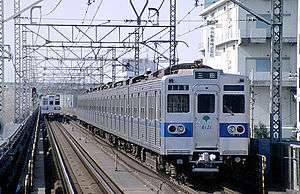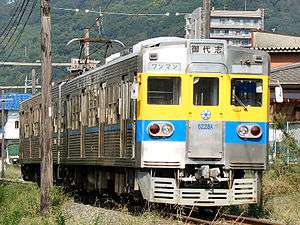Toei 6000 series
The Toei 6000 series (東京都交通局6000形) is an electric multiple unit (EMU) train type operated by the Tokyo subway operator Tokyo Metropolitan Bureau of Transportation (Toei) on the Toei Mita Line in Tokyo, Japan, between 1968 and 1999, and subsequently on the Chichibu Railway (since 1999), Kumamoto Electric Railway, and Kereta Commuter Indonesia in Indonesia (from 2000 until 2016).
| Toei 6000 series | |
|---|---|
 Set 6121 on the Toei Mita Line in February 1999 | |
| In service | 1968–1999 (Toei Mita Line) |
| Manufacturer | Kawasaki Heavy Industries, Nippon Sharyo, Alna Kohi, Hitachi |
| Constructed | 1968–1976 |
| Entered service | December 1968 |
| Number built | 168 vehicles (28 sets) |
| Number in service | 24 vehicles (10 sets) |
| Number preserved | 2 vehicles |
| Successor | Toei 6300 series |
| Formation | 6 cars per set (Toei Mita Line) 8 cars per set (Kereta Commuter Indonesia) 3 cars per set (Chichibu Railway) 2 cars per trainset (Kumamoto Electric Railway) |
| Capacity | 150 (50 seating) (end cars), 170 (58 seating) (intermediate cars) |
| Operator(s) | Toei Subway (1968-1999) Chichibu Railway (1999-present) Kumamoto Electric Railway (1999-present) Kereta Commuter Indonesia (2000-2016) |
| Line(s) served | Toei Mita Line |
| Specifications | |
| Car body construction | Stainless steel |
| Car length | 20 m (65 ft 7 in) |
| Width | 2.790 m (9 ft 1.8 in) |
| Height | 3.690 m (12 ft 1.3 in), with pantograph: 4.045 m (13 ft 3.3 in) |
| Doors | 4 pairs per side |
| Maximum speed | 70 km/h (operating), 100 km/h (design) |
| Weight | 215.5t |
| Traction system | Resistor control |
| Power output | 2400 kW |
| Acceleration | 3.5 km/h/s |
| Deceleration | 4.0 km/h/s (service), 5.0 km/h/s (emergency) |
| Electric system(s) | 1,500 V DC |
| Current collection method | Overhead wire |
| Bogies | KD-70 |
| Braking system(s) | Dynamic braking, electromagnetic direct brake |
| Safety system(s) | T-ATS |
| Coupling system | Janney coupler |
| Track gauge | 1,067 mm (3 ft 6 in) Narrow Gauge |
Operations
The 6000 series operated on the Toei Mita Line from its opening in 1968.[1]
History
The 6000 series won the 1969 Laurel Prize from the Japan Railfan Club.
Exterior
Originally delivered with unpainted stainless steel front ends, the blue bodyside bands were extended to the front ends from 1988.[1]
Resale

Following withdrawal from the Toei Mita Line in 1999 and replacement by Toei 6300 series EMUs, a number of former 6000 series units were resold to other railway operators in Japan and also donated to KA Commuter Jabodetabek in Indonesia.[2]
- Chichibu Railway 5000 series 3-car sets
- Kumamoto Electric Railway 6000 series 2-car sets
- KRL Jabodetabek 6000 series
Chichibu Railway 5000 series

12 former 6000 series cars were sold to the Chichibu Railway in 1999, where they were reformed as four three-car 5000 series sets.[2]
The original Toei car numbers and subsequent identities were as follows.[2]
| Toei numbering | Chichibu numbering |
|---|---|
| 6191 | 5001 |
| 6196 | 5101 |
| 6198 | 5201 |
| 6241 | 5002 |
| 6246 | 5102 |
| 6248 | 5202 |
| 6251 | 5003 |
| 6256 | 5103 |
| 6258 | 5203 |
| 6261 | 5004 |
| 6266 | 5104 |
| 6268 | 5204 |
Indonesia
72 former 6000 series cars were donated to KRL Jabodetabek (later KA Commuter Jabodetabek) in Indonesia in 2000 as part of an Official development assistance (ODA) programme to upgrade commuter train services in the Jakarta area.[3]
Eight six-car sets (6121, 6151, 6161, 6171, 6181, 6201, 6271, and 6281) and 24 middle cars were shipped to Indonesia, entering revenue service there from August 2000.[3] In 2004, the trainsets were reformed into eight six-car sets and three eight-car sets, made possible by rebuilding some former intermediate cars with new driving cabs.[3] The fleet subsequently underwent further extensive reorganization and rebuilding of driving cars damaged in accidents.[3]
Withdrawals commenced in December 2012 with set 6201, displaced by an increasing number of newer and longer trains delivered from Japan.[3] The last set to remain in service, 6181, was repainted into the new KA Commuter Jabodetabek red livery in February 2016, before finally being withdrawn in September 2016.[3]
Since February 2018, car 6181 from the last operating set, 6181F, is now preserved in Depok EMU Depot as a static display, with electrical systems such as lighting and automatic door fully operational, due to some modifications to the train.[4]
 Former set 6171 in Indonesia in May 2011
Former set 6171 in Indonesia in May 2011- Former Toei 6000 series set in Indonesia with rebuilt front end in July 2007
- Car 6151 with a rebuilt front end as part of a 4-car set in November 2011
 Set 6177 with a rebuilt front end in November 2014
Set 6177 with a rebuilt front end in November 2014 Former set 6181 in "KCJ" livery in September 2016
Former set 6181 in "KCJ" livery in September 2016 Former set 6281 awaiting scrapping in Indonesia in December 2016
Former set 6281 awaiting scrapping in Indonesia in December 2016
References
- The 地下鉄 [The Subway]. Japan: Sansuisha. 29 September 2004. p. 127. ISBN 978-4-06-366218-4.
- Kubo, Satoshi (April 2008). 秩父の電車たち [Trains of the Chichibu Railway]. Japan Railfan Magazine. Vol. 48 no. 564. Japan: Koyusha Co., Ltd. pp. 92–99.
- Takagi, Satoshi (February 2017). ジャカルタへ渡った都営6000形 [The 6000 series that travelled to Jakarta]. Japan Railfan Magazine (in Japanese). Vol. 57 no. 670. Japan: Koyusha Co., Ltd. p. 126–129.
- "Railway Enthusiast Digest: Toei 6000 Jadi Monumen di Dipo Depok".
External links
| Wikimedia Commons has media related to Toei 6000 series. |
- Toei rolling stock gallery (in Japanese)
